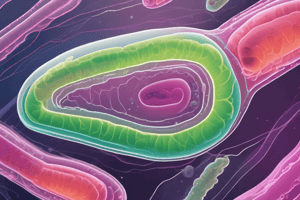Podcast
Questions and Answers
Which characteristic is unique to Chlamydia compared to Escherichia?
Which characteristic is unique to Chlamydia compared to Escherichia?
- Existence as normal flora in the gastrointestinal tract
- Capacity to exchange genetic material with other bacteria
- Obligate intracellular parasitic lifestyle (correct)
- Ability to thrive in both aerobic and anaerobic conditions
Why is it crucial to treat Chlamydia trachomatis infections promptly?
Why is it crucial to treat Chlamydia trachomatis infections promptly?
- To prevent the development of antibiotic-resistant strains of _Escherichia coli_.
- To avoid potential complications such as blindness and sexually transmitted infections. (correct)
- To eradicate the bacteria before they colonize the gastrointestinal tract.
- To reduce the risk of developing unrelated secondary infections.
Enteroinvasive Escherichia coli (EIEC) strains share a pathogenic mechanism most similar to which other bacterial genus?
Enteroinvasive Escherichia coli (EIEC) strains share a pathogenic mechanism most similar to which other bacterial genus?
- Staphylococcus
- Streptococcus
- Salmonella
- Shigella (correct)
A newborn nursery is experiencing an outbreak of diarrhea caused by Escherichia coli. Which specific type of E. coli is the most likely culprit?
A newborn nursery is experiencing an outbreak of diarrhea caused by Escherichia coli. Which specific type of E. coli is the most likely culprit?
How do enterotoxigenic Escherichia coli (ETEC) strains cause diarrheal diseases?
How do enterotoxigenic Escherichia coli (ETEC) strains cause diarrheal diseases?
What characteristic defines Escherichia coli as benign commensals rather than virulent pathogens?
What characteristic defines Escherichia coli as benign commensals rather than virulent pathogens?
Flashcards
What is Chlamydia?
What is Chlamydia?
Obligate intracellular parasitic bacteria, common cause of bacterial sexually transmitted infections and infectious blindness.
Common Chlamydia treatment?
Common Chlamydia treatment?
Tetracycline and erythromycin
What is Escherichia?
What is Escherichia?
Non-spore-forming, facultatively anaerobic, rod-shaped bacteria, normal inhabitants of the gastrointestinal tract.
What do ETEC E. coli strains do?
What do ETEC E. coli strains do?
Signup and view all the flashcards
What do EIEC E. coli strains do?
What do EIEC E. coli strains do?
Signup and view all the flashcards
What do EPEC E. coli strains do?
What do EPEC E. coli strains do?
Signup and view all the flashcards
Study Notes
- Chlamydia are obligate intracellular parasitic bacteria.
- They are the most common cause of bacterial sexually transmitted infectious blindness.
- Medically important Chlamydia species: C trachomatis, C pneumoniae, and C psittaci.
- Tetracycline and erythromycin treat chlamydial infections.
- Escherichia are non-spore-forming, facultatively anaerobic, rod-shaped bacteria.
- They normally inhabit the gastrointestinal tract.
- They are benign commensals unless they acquire virulence factors.
- Three groups of E. coli cause diarrheal diseases.
Diarrheal E. coli Groups
- ETEC (enterotoxigenic): Produce enterotoxins.
- EIEC (enteroinvasive): Invade tissues, causing destruction and inflammation similar to Shigella.
- EPEC (enteropathogenic): Associated with diarrhea outbreaks in newborn nurseries, but no toxins or invasion factors are recognized.
Studying That Suits You
Use AI to generate personalized quizzes and flashcards to suit your learning preferences.




